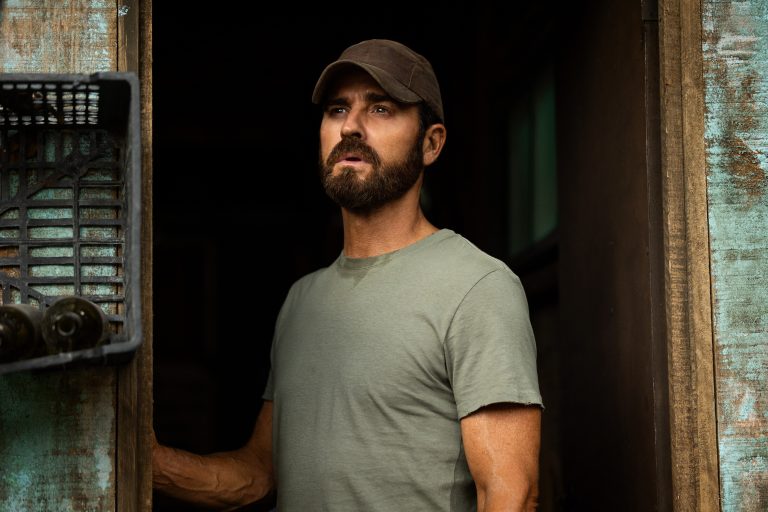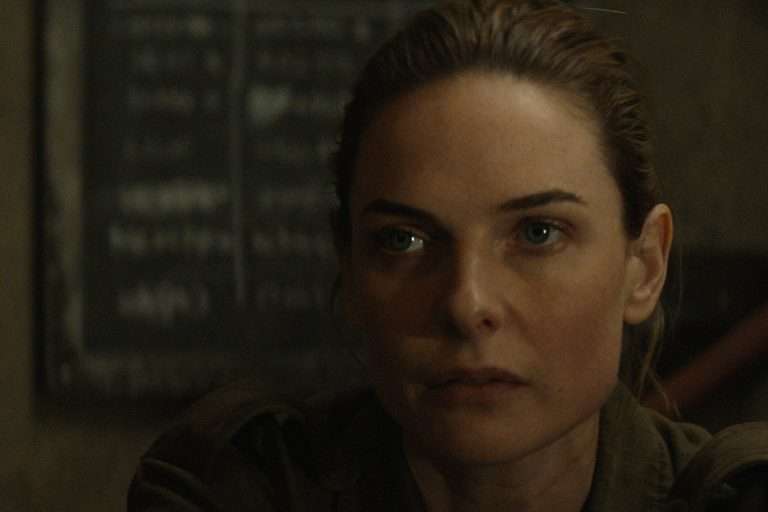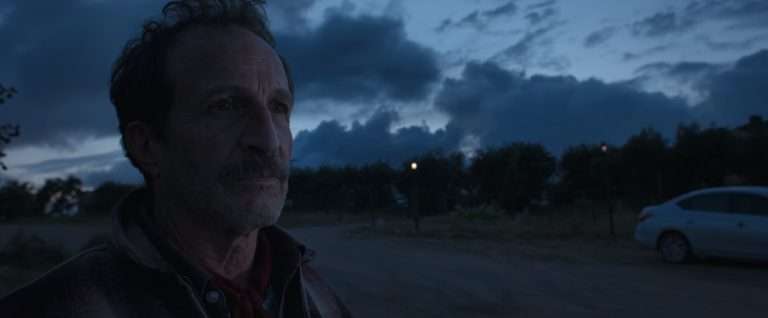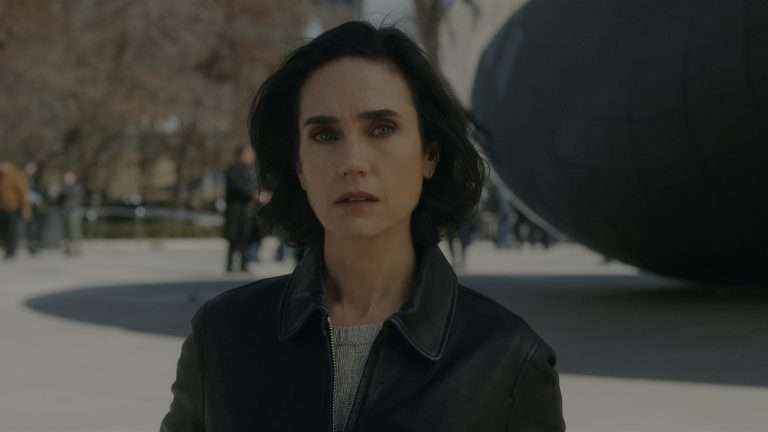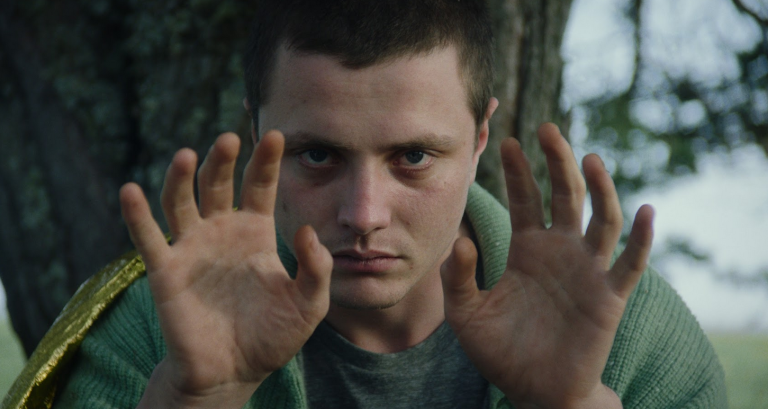Onimusha (Netflix) Season 1: Review, Recap, and Ending Explained: From the outset, Onimusha is a pretty interesting, if derivative, video game concept: taking and utilizing celebrated figures of Japanese history and then incorporating them with supernatural elements. It gives both gamers and storytellers interested in dabbling in historical fiction a new sandbox to play in, to vicariously voice these celebrated characters and imagine them facing off against undead demons. It is corny, but not if you are Takashi Miike.
One of the best-known and most prolific directors of Japan working today, Miike is known for his highly provocative tone in filmmaking and for trying to push the envelope in storytelling regarding character motivations amidst traditional genre trappings. That is why even his remakes of Japanese classics like 13 Assassins or Graveyard of Honour stand out because of his own additions or revisions to the original material. Miike is also no stranger to anime adaptations – having helmed live-action adaptations of Blade of the Immortal and Jojo’s Bizzare Adventure, and he has also helmed a video game adaptation of Ace Attorney.
In Onimusha (season 1), though, he takes his fandom and love of characters and recontextualizes them from a surface level to such a surprising degree that you are forced to wonder whether it is an uncanny valley you are witnessing. Is it fandom to watch a samurai clearly looking like Toshiro Mifune in “Yojimbo” and “Sanjuro,” playing the character of Mushashi Miyamoto from “The Samurai Trilogy,” or is it just tongue-in-cheek humor? I suppose it is a bit of both, though I will have to admit, it did help me immerse myself in the experience of watching it.
Recommended Read: The 10 Best Horror Anime Shows on Netflix
Onimusha (Netflix) Season 1 Recap
Onimusha begins on a dark rainy afternoon, like the Japanese fables of old. Mushashi Miyamoto faces down multiple men surrounding him to ostensibly complete a challenge. A single autumn leaf falls, and the battle commences. Amidst the myriad of gorgeously animated action sequences, with gore plentiful, it doesn’t take long for Miyamoto to emerge victorious. It is revealed that this challenge was an initiation for Mushashi to be granted permission by an enclave of monks guarding an extremely powerful yet extremely secretive weapon. A weapon so secret even Kaizen, the young monk, is unaware of the identity of the weapon.
Only that he is entrusted with the box which contains the weapon for Mushashi, but Kaizen must accompany him on the journey ahead. Miyamoto begrudgingly agrees to keep the weapon for 33 days and have Kaizen around as his babysitter, who would ensure that the weapon is kept safe and sound.
The samurai and the monk exit the temple, and the monk is surprised to find a group of travelers who had been waiting for Miyamoto to obtain his weapon and accompany them on his journey. All of these travelers hail from the same village where, six months earlier, a mysterious incident had led to death and bloodshed, which forced the shogun to send out a scout. The scout, named Iemon, goes missing, however. It is revealed that he has turned rogue, and when a spy is sent to check up on his whereabouts, Iemon tortures the spy and sends him back half-dead.
While traveling, the group takes a break where they try to interact and learn about their intentions. There is Sahei, the intellectual one of the group and the most curious. There is Goro-Maru, a heavy-set warrior and also a falconer, who can utilize his falcons, TTojimaru and Toromaru, as extremely deadly weapons against the undead. Then there is Heikoru, the trickster and the fortune-teller, who uses cards to check up on their luck and who is later revealed to have an encyclopedic knowledge about herbs that could cause harm. And then there is Gensai, one of the few among the three warriors who had been closest to Iemon, and then there is Kensuke Matsui, the master who had trained Iemon and who, as it turns out, is also the traitor in their midst.
To be fair, there would be two traitors. The first traitor would be Master Matsuki, himself swayed by his pupil Iemon’s proclamations that he would be okay with killing the warriors and stopping them from reaching Iemon and the Genma, as had been ordered by the Shogun. Mushashi makes short work of the traitor but is then surprised by Gensai, who is taken over remotely by Iemon and who attacks the group of warriors. It is here that Mushashi uncovers the weapon, a gauntlet called the Oni Gauntlet, which would grant him supernatural powers.
The gauntlet is also used to trap the souls of the monsters called Genma, who have been killed, and it is strongly believed that Iemon is controlling Genma. The gauntlet bears a great physical cost to Mushashi because it aims to transform him into an Oni, even with the powers that aid him in battling the forces. Like the Genma, the Oni are fierce supernatural creatures, but they are not beastly spirits with the intention of harming humans or other living forms.
The remaining warriors soon travel into the village where the incident took place. An abandoned gold mine, which is present at the tail end of the village, is one of the chief reasons for Genma and Iemon to attack the village. They find a young girl named Sayo, the only survivor in that abandoned village, who had been hiding beneath the floorboards of her dead grandparents’ house to escape being killed by the monsters. However, it turns out that the domain must be under the control of Iemon and the Genma because a horde of undead attacks them.
While Mushashi uses the gauntlet with caution because it is taking a toll, he also works with the others to diminish the numbers of the undead, the chief one being destroying Sayo’s grandparents’ house with gunpowder and sealing a majority of the undead inside. After having solved this problem, the group makes the pertinent decision to go back and regroup with an army to attack Iemon. However, they soon find out that the bridge (which Musashi had a hard time crossing because he has a fear of heights) has been cut. Thus, they would have to move forward unwillingly to face Iemon with their limited forces. Sayo wants to accompany them because she wants revenge on the person responsible for wiping her village.
Having Sayo on the team turns out to be a boon for the group because she is a good hunter and a tracker. However, Iemon and we later learn that a group of shadowy warriors working under him uproots the forests and changes the track, leading them to bank near the stream, where they are cornered by a horde of zombies again. They manage to defeat them, but in the process, Goromaru is killed by being impaled with a spear, which also goes through one of his falcons before killing him.
One of the mysterious masked figures and the owner of that spear kidnaps Sayo and escapes. Voices call out to Mushashi, seemingly familiar to him, inviting him to the temple near the mountains. The remaining warriors are all determined to rescue Sayo, while Kaizen is resolute in continuing their mission until Mushashi reminds Kaizen of the Buddhist Dharma, which shuts Kaizen up.
The shocking thing about the mysterious strangers’ identities is that Musashi had previously slain and conquered them, revealed to be the Yoshioka Brothers from Kyoto. This achievement has become recognized as one of Musashi’s greatest. As a result, when the Yoshioka brothers appear on the scene, they have plainly returned from the dead, possessing monstrous talents and otherworldly attributes.
The deceased samurai brothers could only return by assuming the abilities of the Genma being gifted to them. Although the brothers desire to murder Musashi and take his vengeance, Iemon has given them explicit instructions to capture him alive (being whole, though isn’t necessary). Sayo is trapped inside a metal bell by the Yoshioka brothers as part of his instruction to distract the other members of the group from fighting the samurai.
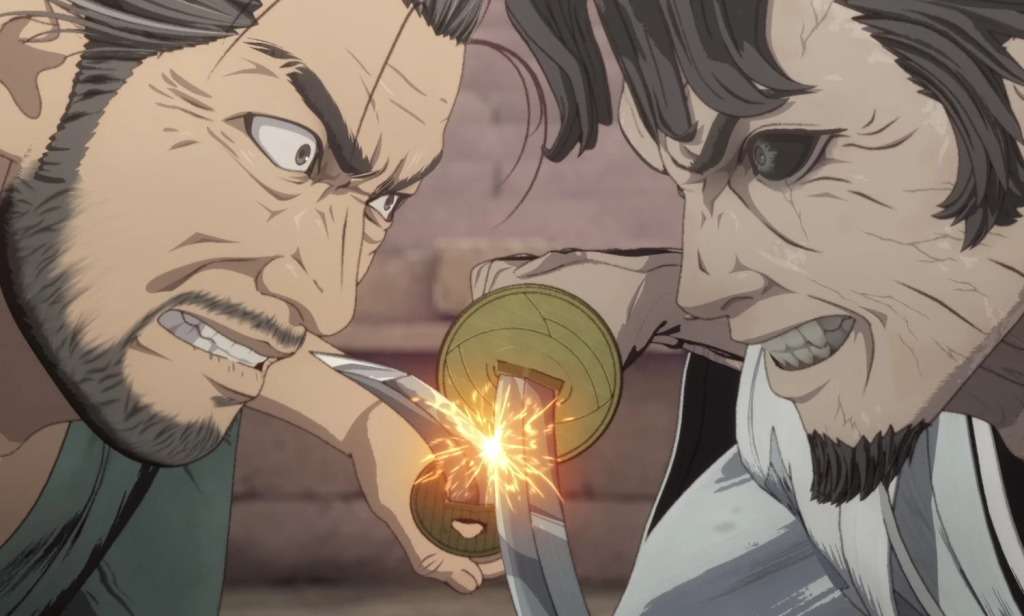
The physical toll taken on him threatens to overpower Mushashi as he wears the gauntlet again and tries to destroy the now demonic-looking Yoshioka brothers, with multiple limbs and swords present. The battle is fierce, though limited by Mushashi’s standards, and he is near death. Meanwhile, the three warriors try to free Sayo from the metal bell by using a large log of wood as a lever to topple it over. However, upon realizing that it isn’t helping, Kaizen hears Sayo praying the sutra, which gives him the strength to push the burning bell over along with the Sahei and Keihoru helping with their lever. They manage to topple over and rescue Sayo, but at the cost of burning Kaizen’s hands and face as he is almost dying of his wounds.
The three brothers had been distracted by the happenings until they realized that Mushashi had given in to the gauntlet’s temptations. The gauntlet heals him, and he becomes strong enough to destroy the Yoshioka Brothers, once and for all, into bloody confetti. But the bloodlust of the Oni had taken control over him, and he was hammering his sword inside the dead body until an injured Kaizen, in his final act, advised Mushashi to remember his humanity and treat the weapon with respect instead of letting it overpower him. Mushashi manages to compose himself, while Kaizen succumbs to his wounds and passes away.
With so much loss incurred from their side, the group is wracked with self-doubt. Heikuro especially wonders and is wracked with guilt, to the extent that he almost runs away from the group while looking after the recuperating Sayo. Musashi keeps on training, harnessing his old muscles, practicing his moves, and swinging the blades. Sayo, meanwhile, remembers her family and has a breakdown where she admits to Musashi that she was the one who discovered the gold in the mine, so she is inadvertently responsible for everything that is currently occurring. This is the time when Musashi, in a moment of introspection, tells her not to carry that guilt because it is not hers to bear.
After Heikuro finally regains his confidence, choosing to return as the sole brother, Sahei leaves to continue this mission. They reach the mine, where, surprisingly, a form of underground castle is built within it. They are met by Iemon’s butler, Alfred, who pretends to be shocked that the warriors don’t listen to his demands and surrender to Iemon. Sayo especially has had enough and asks for her parents, whom she believes are alive. After finally realizing that negotiating with these warriors is a lost cause, Alfred calls upon his loyal soldier—an undead centaur-like zombie pulling a zombie—and hops on, shooting the warriors with an enchanted musket, with the soldier also firing with a bow and arrow.
The two of them are lethally precise, and soon, the warriors start getting overpowered. Finally, Heikuro realizes the reason for his existence until this juncture. He gives the remaining three what is revealed to be an antidote before releasing a powerful powdered hallucinogenic. He gets impaled by the arrows, but that doesn’t stop him. Instead, he pulls the arrows out and lets the fresh blood pouring out of his body mix with the smoke. That is enough to activate the hallucinogen, which is powerful enough to disorient Alfred and the soldier. The soldier’s chariot overturns, and he dies in a cloud of smoke, while Musashi finally manages to finish the job by killing Alfred.
Onimusha (Netflix) Season 1 Ending Explained
What Happens to Sayo’s Parents?
The death of Alfred leads to the revelation of Sayo’s parents being alive. However, it turns out to be a ruse because Iemon, from the shadows, starts controlling them into choking their reunited daughter. Taunting Musashi to make a decision, Musashi is forced to do the unthinkable and slice their heads off from their bodies, killing and freeing them from control. But it leads thematically Musashi to lose his last shred of humanity and be open to being susceptible to the Oni’s whisperings.
What was Iemon’s Plan?
Many years ago, Kensuke Matsuki, the village head and teacher of the samurai way of warfare, noticed a little kid interested in the same, having stolen a sword belonging to his former pupil and practicing swings. Despite his initial misgivings, Matsuki eventually began training this youngster, giving him the formal name Iemon (the name of his former pupil) and a sword to signify the start of his training. At that very moment, the youthful ally had disclosed to his boss the precise convictions and visions he held concerning the samurai of the region.
It matches up with the history of the period, as “Onimusha” takes place during the Edo period (1603-1868) when the shogunate ruled and Japan enjoyed a relatively peaceful time. But that, according to Iemon, rendered the samurai worthless. Because the samurai are now the official tools of the shogunate rather than having a power of their own. It effectively neuters them, especially if they are invaded by a foreign land, especially the West. Iemon’s solution is to create a second form of the Battle of Sekigahara (1600), which occurred between different coalitions of samurai clans and led to the creation of the Tokugawa Shogunate.
A second version of such would be a culling to weed out and produce the strongest samurai who will join in the case of protecting Japan out of the thumb of the Shogunate. Mitsuki’s reaction was almost overwhelmingly positive, a sharp cry from Musashi’s reaction at the present time when Iemon offers the same pitch to him, and he refuses. The gold that had incited this entire event had been to work on his deadly samurai army. He already has the power of the Genma at his disposal, having sided with the evil spirits, and now the gold would provide him infinite resources to create an unstoppable army that could conquer this hemisphere.
Who is Sasaki Kojiro?
Sasaki Kojiro was a Japanese swordsman who is best remembered for his fatal combat with Miyamoto Musashi in 1612. Sasaki Kojiro may have lived in the early Edo era. Despite experiencing both loss and death at the hands of Musashi, he is regarded as a highly esteemed warrior in Japanese history and society. In Onimusha, he is revealed to have been resurrected by Iemon using the magic of the Genma, and he is very grateful for resuming their battle for a second time. He is so insistent on having a battle with Miyamoto that he dismembers Iemon because he refuses to follow Iemon’s orders and bring Miyamoto alive.
The resultant battle that occurs between Sasaki and Musashi could only be described as intense, with the demonic Sasaki using enhanced versions of his famous attacks to get an advantage over the skilled Musashi adorned with the gauntlet. Sasaki, to make the battle more intense, even chooses to kill all the zombies accompanying him and even chooses to destroy his extra arms because they have been getting in the way. In retaliation, Musashi, too, gives in to the power of the Oni Gauntlet, becoming a true Oni.
Who Is the Third Traitor?
At the start of Onimusha, Musashi revealed that there had been a third traitor among their group. Two events occur that reveal this information in unforeseen ways. On the one hand, Iemon, even in dismembered form and through sheer will, chooses not to die and instead crawls his way to his office. Meanwhile, Sahei and Sayo, under instructions from Musashi, had chosen to hide deeper into the mine and find a way out. They come across the injured Iemon, who implores Sahei to help him out, as both of them had been disciples of Matsuki.
To Sayo’s shock, Sahei seems to go along with the plan, taking Iemon to the office table while Iemon describes his plans for world dominance. However, a twist occurs when Sahei chokes Iemon and then poisons him with one of Heikuro’s medicines. Once that deed is done, Sahei reveals that he has been sent (presumably by the Shogunate) to silence anyone who has information about the gold mine, and thus, he moves threateningly to silence Sayo. Except now, he is disillusioned by the entire endeavor and lets Sayo go, avoiding the killing of the little girl. The last we see of Sahei is him moving in the tunnels of the mine before, presumably, being swallowed by the roof caving in.
What Happens to Sayo and Musashi at the End?
Sayo manages to interrupt a destructive battle between demonic Musashi and demonic Sasaki. In a manner that could be described as heartfelt at best and corny at worst, she forgives Musashi for the killing of her parents because she realizes that by doing this deed, he has made sure that her parents retained their humanity and wouldn’t have to survive as Genma. The grip of the Oni loosens from Musashi, and he returns to his normal state.
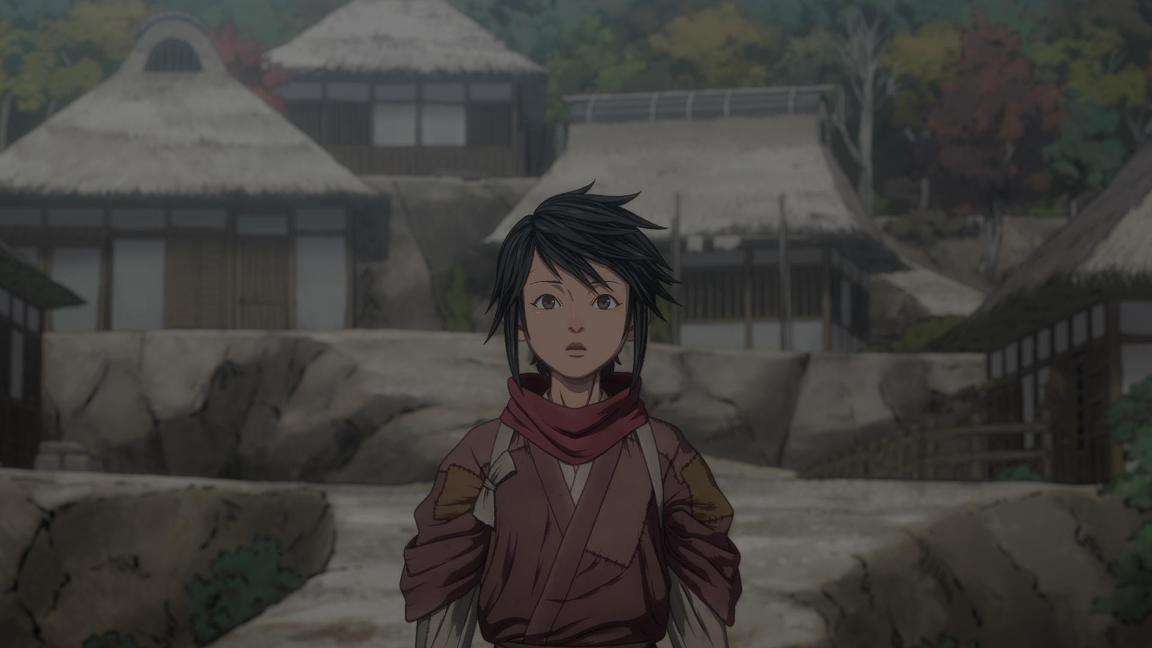
However, he also realizes that this final battle might be destiny’s call, and when he notices that one of the falcons has found a way inside the cave, he instructs Sayo to follow it outside, giving her the gauntlet as well. Before she leaves, she asks Musashi to grow up and stop goofing around. Ironically, as she leaves, Musashi rows a boat towards a platform to face his finest opponent for one final time, bringing his life to full circle. As the two of them face off, with Musashi fighting with a large chunk of a canoe instead of a sword, the mine collapses all over them.
As Sayo walks out of the mine, she looks at the collapsing mine and offers up a silent prayer, knowing full well she will never see Musashi again. She returns to the village, where she uses Kaizen’s necklace as a way to gain access to a rest house while using a gold nugget to gain access to the temple, where she leaves the gauntlet anonymously. The monk in charge of the gauntlet remarks that the gauntlet had become heavier, indicating the souls housed within it. Onimusha ends with a single snowflake falling on the gauntlet.
Onimusha Netflix (Season 1) Review:
As far as video-game adaptations go, you could do worse than Onimusha from a narrative standpoint. It actually heralds a positive change in video game adaptations, with creators actually keeping track of narrative fidelity as well as maintaining entertainment without resorting to self-reflexive snark.
The animation does take some getting used to with the pencil-scratched detailing over the 3D models of the animation, resulting in motion and expressiveness being slower and even blockier. In contrast, the action set pieces are quite smooth because there are some moments of fluidity in the 2D animation interspersed. You couple that with Miike’s proclivity for showcasing gore and violence, and as a visual feature, Onimusha is a delight, especially in terms of action sequences. There are moments, especially in the flashback sequences, where the animators use complete 2D animation to differentiate between the timelines, and those segments do feel like a welcome respite.
Also, Read: Good Night World (Season 1) Netflix Series: Recap & Ending Explained: Are the humans living in Taichiro’s world?
It is also curious in terms of how it chooses to frame Japanese history as well as depict real-life characters. Miyamoto, especially as depicted by Toshiro Mifune, is not an accidental choice. Mifune had previously depicted the character in “The Samurai Trilogy”(1954-1956), and I will argue this might constitute a fascinatingly weird continuation of the same. In hindsight, though, even as the anime strives to explain who these characters are, it is still possible to feel a bit lost, especially with how the characters are being introduced. Sasaki takes up the moniker of the big bad at the tail end of this season, and with how he is built up and introduced, it is easy to infer that these are important characters in Musashi’s backstory but difficult to connect.
As far as storytelling goes, Onimusha season 1 is by the numbers; the animation and creative directors are clearly more focused on the action than on character motivations. But other than Sayo and Musashi, none of the characters get enough time to be fleshed out before they are taken off the board. Musashi, I can argue, is a unique case of plot armor as well as visage armor. There is no way that Miike, being as provocative as he is, would kill his main character, who has the visage of Toshiro Mifune, purely for shock value. But it does give the apparent realization of a fully fleshed-out character rather than actually having one. Then again, Onimusha is a show where you get to see Mifune in a sort of Jidaegaki movie, fighting supernatural monsters. Call me crazy, but this is a weird form of fan service, and I am here for it.
★★★




